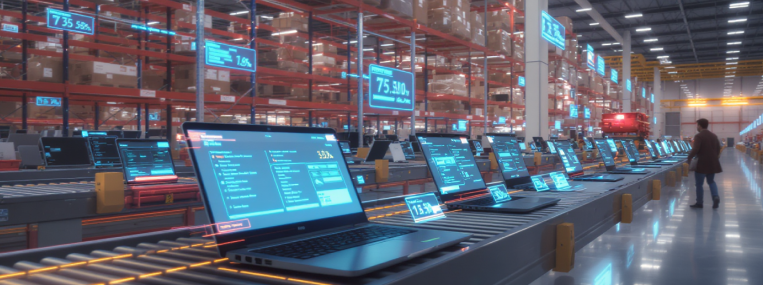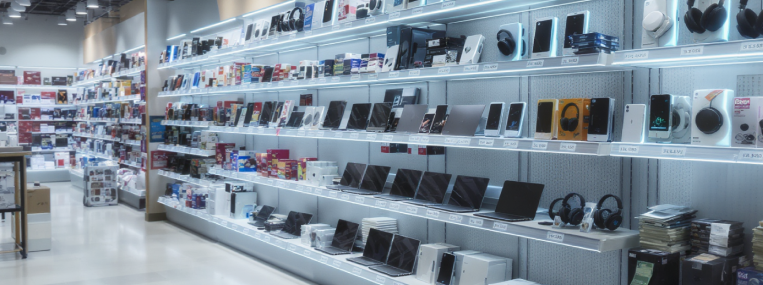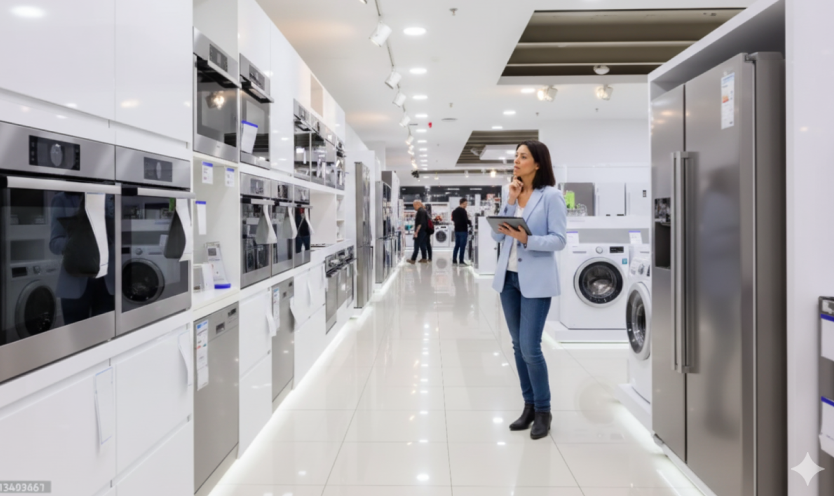Competing in Milliseconds: How AI Keeps Electronics Pricing Ahead of the Market
Competing in Milliseconds: How AI Keeps Electronics Pricing Ahead of the Market
In the world of consumer electronics, the market never sleeps. Prices shift by the minute, competitors move in milliseconds, and customers know exactly how much a product costs across multiple platforms before making a purchase. In this high-velocity category, success is no longer about who offers the lowest price, but about who can move the fastest while staying profitable.

Laptops, smartphones, and accessories often fluctuate in price several times a day across major marketplaces. A single delay in updating a price can mean losing the “buy box,” missing out on volume, or selling below cost. For electronics retailers and brands, pricing has become a real-time race where milliseconds can make millions in difference.
Yet, keeping up manually is impossible. Spreadsheets, weekly audits, or static rule-based pricing engines simply can’t compete with today’s dynamic environment. What retailers need is intelligence that can monitor, analyze, and act instantly, precision powered by AI.
This is where Hypersonix Pricing AI and Competitor AI give electronics retailers a measurable edge, turning real-time market chaos into an opportunity for control, agility, and profit.
Before understanding how AI changes the game, it’s important to recognize why electronics pricing is uniquely demanding compared to other retail categories.
The Challenge: Real-Time Competition in a Transparent Market
Few industries are as brutally competitive as consumer electronics. Products are high-value, fast-moving, and globally comparable. A single product can appear across dozens of retailers and marketplaces, often with identical specifications. This transparency creates a pricing environment where even a small difference can redirect thousands of customers instantly.

Add to that the constant churn of product launches, rapid obsolescence, and seasonal promotions, and the complexity multiplies. Prices that make sense today may be outdated by tomorrow morning.
Traditional pricing systems, designed for slower-moving categories, simply can’t handle this pace. They rely on static rules and periodic updates, a process too slow for a market that changes by the hour. When competitors adjust prices dynamically, retailers using outdated systems end up reacting too late or too aggressively, both of which hurt margins.
In electronics, timing is everything. The brands that win are not necessarily the cheapest, but the most adaptive, those that know when to adjust, when to hold, and when to strategically lead.
This speed-driven reality has made AI not just an advantage, but a necessity. The pace and transparency of this market expose the weaknesses of legacy pricing models, especially those that rely on manual control or static rules.
Why Manual and Rule-Based Pricing Falls Behind
In many retail categories, pricing once followed a relatively predictable rhythm: monitor weekly, analyze monthly, and adjust quarterly. In electronics, that timeline has collapsed into real time.
The problem is that manual or rule-based pricing systems still operate in snapshots, not streams. They capture competitor data once or twice a day, apply static markup rules, and assume the market remains stable between updates. In reality, electronics pricing is anything but stable.
A rival retailer’s flash sale can trigger instant repricing across an entire marketplace. Suppliers can change costs overnight due to currency shifts or component shortages. Without a system that can detect these changes as they happen, pricing decisions quickly fall out of sync with the market.
When this happens, two costly outcomes emerge:
-
Underpricing, where margins shrink because the retailer fails to recognize that competitors have already raised their prices.
-
Overpricing, where outdated price points make a retailer instantly uncompetitive, causing loss of traffic and sales velocity.
Both outcomes drain profitability and erode brand trust.
This is where AI-driven real-time monitoring shifts pricing from reaction to anticipation, giving electronics retailers the ability to compete dynamically, not desperately. As these outdated methods struggle to keep up, AI-driven systems emerge as the only sustainable way to compete in markets that move faster than human decision-making ever could.
How Hypersonix Keeps Pricing Ahead of the Market
Hypersonix’s Competitor AI and Pricing AI are designed precisely for categories like electronics, where speed and accuracy define success. Together, they turn market volatility into strategic intelligence.

Here’s how the system works to keep retailers ahead of the curve:
-
Real-Time Competitive Tracking
Hypersonix continuously monitors competitor prices, promotions, and assortments across online marketplaces and direct retail sites. The system updates multiple times per day, ensuring that retailers always have the latest insights. Instead of relying on snapshots, they operate with a live feed of market data. -
AI-Powered Product Matching
Electronics pricing presents a unique challenge: similar SKUs often appear under different product names or bundle configurations. Hypersonix solves this using AI-driven product matching that leverages computer vision, natural language processing, and attribute mapping. This ensures that retailers are comparing true equivalents, not mismatched listings, enabling fair and accurate competitive comparisons. -
Predictive Pricing Recommendations
Once real-time market data is gathered, Pricing AI uses predictive analytics to simulate multiple pricing outcomes. It evaluates how customers are likely to respond to a potential price change, factoring in demand elasticity, competitive behavior, and margin targets. This allows retailers to make proactive adjustments instead of reactive cuts. -
Automated Alerts and Agentic Workflows
When the system detects significant market movement, for example, a competitor drops a laptop price by 5%, Hypersonix generates instant alerts with context and recommended actions. Pricing managers can review, approve, or automate these updates, ensuring decisions happen in minutes rather than days. -
Explainable Intelligence for Confidence and Control
Every pricing recommendation comes with a clear rationale, showing what triggered the change and its projected financial impact. This explainable AI ensures teams understand not just what to do, but why, maintaining human oversight and trust even at machine speed.
Through this continuous loop of detection, analysis, and action, Hypersonix helps electronics retailers maintain competitive agility without compromising profit discipline.
But agility alone isn’t enough; the real advantage comes from understanding how these fast, data-driven reactions protect long-term brand value. Without strategic intelligence, reacting too quickly can be just as damaging as reacting too slowly.
Balancing Speed with Strategy: Competing Without a Race to the Bottom
In a market driven by speed, the temptation to react instantly to every competitor move is strong. However, reacting without strategy can trigger destructive price wars that erode profitability for everyone involved.
Hypersonix avoids this pitfall through elasticity modeling, a core Pricing AI capability that measures how sensitive customer demand is to price changes. This means that not every competitor discount requires a matching response.
For example, if a rival temporarily discounts gaming monitors by 10%, Hypersonix may determine that the elasticity in your category allows you to maintain current pricing without losing meaningful volume. On the other hand, if a price drop in a high-velocity item like smartphones begins shifting share rapidly, the system recommends a competitive yet margin-safe response.
By combining market speed with demand intelligence, electronics retailers can maintain price credibility and protect their margins, winning the right battles, not all of them.
This balance between agility and restraint is what defines successful pricing leadership in high-velocity markets. The key to success lies in precision, not just in analysis, but in how insights translate into real-world execution that customers actually experience.
Turning Data into Execution: Where Decisions Meet Results
Real-time insights are powerful, but their value depends on execution. Delays between decision and implementation can nullify even the smartest pricing strategies.

This is why Hypersonix Price Execution Monitoring ensures that every approved pricing update is accurately reflected across all sales channels. It continuously validates that the prices customers see, whether on marketplaces, brand websites, or in-store displays — match the intended strategy. If discrepancies appear, teams are immediately notified to correct them.
This synchronization between intelligence and execution prevents silent margin losses and ensures consistent brand perception. In the electronics space, where customers often compare multiple tabs before making a purchase, consistency can be the difference between winning and losing the sale.
With Hypersonix, retailers don’t just know the right price, they make sure it’s live everywhere it matters. Even with flawless execution, trust remains essential. Retailers need complete clarity on why pricing decisions are made before they can confidently scale.
The Competitive Advantage of Explainable AI
The electronics category thrives on precision, and so must the technology that manages it. Hypersonix’s Explainable AI ensures that decision-makers understand every recommendation’s logic, input, and outcome.
This transparency builds organizational trust and adoption. Category managers can validate AI-driven suggestions, finance teams can model projected profit impact, and executives can see measurable ROI, all from a single, unified platform.
By combining explainability with automation, Hypersonix bridges the gap between human strategy and machine execution, ensuring that decisions are fast but never blind.
Conclusion
In the electronics industry, where prices shift in seconds and competition moves faster than human reaction, the margin between winning and losing often comes down to milliseconds.
Hypersonix AI turns this speed into strategy. With real-time competitive tracking, product matching, elasticity modeling, and price execution monitoring, it gives eCommerce and retail brands the power to act faster, smarter, and more profitably.
In a world where every click, price change, and promotion matters, intelligence is the new speed. The future of electronics pricing belongs to those who can move with precision, not panic, and with Hypersonix, that future is already here.






